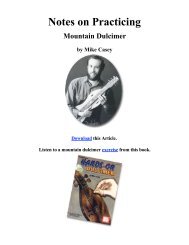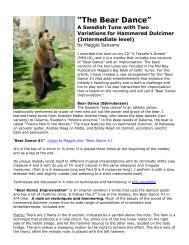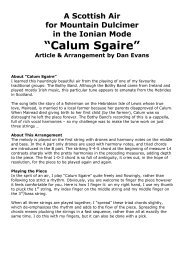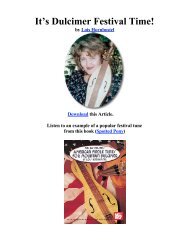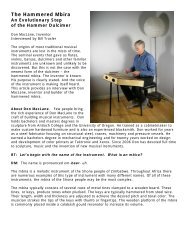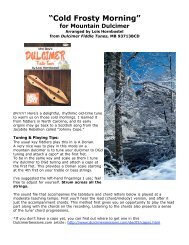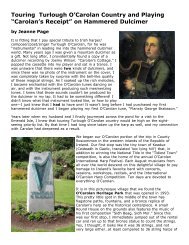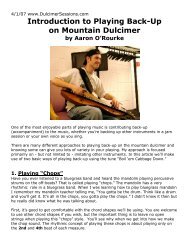Variations in Mountain Dulcimer Playing - Mel Bay's Dulcimer ...
Variations in Mountain Dulcimer Playing - Mel Bay's Dulcimer ...
Variations in Mountain Dulcimer Playing - Mel Bay's Dulcimer ...
Create successful ePaper yourself
Turn your PDF publications into a flip-book with our unique Google optimized e-Paper software.
<strong>Variations</strong> <strong>in</strong> Mounta<strong>in</strong> <strong>Dulcimer</strong> Play<strong>in</strong>g<br />
by Karen Mueller<br />
One of my favorite approaches to arrang<strong>in</strong>g music is to develop variations of traditional tunes.<br />
This is the same technique used by a bluegrass musician when he or she plays a “break,” a<br />
melody l<strong>in</strong>e that’s related to the orig<strong>in</strong>al and reta<strong>in</strong>s the same chord structure, but is somehow<br />
different. One workshop that I offer at festivals discusses how play with greater variety and<br />
dynamics <strong>in</strong> your music, after you’ve learned the tune itself. These ideas can help you whether<br />
you’re consider<strong>in</strong>g enter<strong>in</strong>g a contest, mak<strong>in</strong>g a record<strong>in</strong>g, perform<strong>in</strong>g, or just play<strong>in</strong>g for your<br />
cat at home.<br />
Ways to add variety to your arrangements:<br />
1. Dynamics: Contrasts like high/low; loud/soft; slow/fast.<br />
2. <strong>Dulcimer</strong> techniques: <strong>Mel</strong>ody over drone /melody with harmony /melody-chord arrangements;<br />
crosspick<strong>in</strong>g or f<strong>in</strong>gerpick<strong>in</strong>g vs. strumm<strong>in</strong>g or flatpick<strong>in</strong>g; <strong>in</strong> DAD, play<strong>in</strong>g the melody on the<br />
high str<strong>in</strong>g, bass str<strong>in</strong>g or both together; us<strong>in</strong>g harmonics.<br />
3. Musical tricks: Emphasize the "downbeat" (beats 1 & 3) vs./ "back beat" (2 & 4); try the same<br />
song <strong>in</strong> a different time signature, like do<strong>in</strong>g a 4/4 fiddle tune as a waltz (3/4) or jig (6/8); come<br />
up with a unique <strong>in</strong>troduction and tag for a tune.<br />
4. Improvise a variation of the melody. First, you must know the piece well, def<strong>in</strong>itely<br />
memorized. Know the backup chord structure of the piece, aga<strong>in</strong>, by heart. Try to make up a<br />
harmony part for the tune as a variation. Use scales and arpeggios (broken chords) that<br />
correspond to the appropriate backup chord to play over the chord changes. Take a tune you<br />
really know and like, and play around with it!<br />
I developed my arrangement of the fiddle tune “Kitchen Gal” for my “Still Po<strong>in</strong>t,” CD by<br />
“fiddl<strong>in</strong>g around” with the tune over and over (and over!). On this record<strong>in</strong>g, which you can hear<br />
here, I play the tune four times. I beg<strong>in</strong> with an <strong>in</strong>troduction based on the last four measures of
the tune, played slowly and accelerat<strong>in</strong>g at the end. The first complete time through the tune I<br />
play it straight, true to the orig<strong>in</strong>al melody as it would appear <strong>in</strong> a fiddle tune book. It’s important<br />
to establish the roots of the tune before fly<strong>in</strong>g to the moon with it. The tempo is moderate, and<br />
the emphasis is on the down beat, beats 1 and 3, which is the most common feel<strong>in</strong>g <strong>in</strong> 4/4 time.<br />
This version appears <strong>in</strong> <strong>Mel</strong> Bay’s 2000 <strong>Dulcimer</strong> book and looks like this:
The second time through the tune (“Variation 1”), I shift the emphasis to the back beat, beats 2<br />
and 4. This gives it a nice old-time feel<strong>in</strong>g, more common for danc<strong>in</strong>g. The tempo is still relaxed.<br />
In the B part, I play the melody <strong>in</strong> unison octaves and ascend to the higher frets. Near the end<br />
(measures 20-22), I use a rather “crooked” rhythm that has a more jazz-like feel<strong>in</strong>g. There’s a<br />
build-up of the energy <strong>in</strong> the music at this po<strong>in</strong>t that will be relaxed for the next time through the<br />
tune. This is a technique (tension and release) used <strong>in</strong> any narrative art form, from music to<br />
storytell<strong>in</strong>g, and we’re us<strong>in</strong>g it to create a cohesive “story” <strong>in</strong> the arrangement. The last two<br />
measures shift to 6/8 time to transition to the next variation.
“Variation1”
The third time through the tune (“Variation 2”), I play it as an Irish jig, <strong>in</strong> 6/8 time. The melody<br />
has to be altered a bit to make the transition, and this adds to the variety of the arrangement. Use<br />
an “out-<strong>in</strong>” strum as much as possible, as established by the quarter note/eighth note pairs. When<br />
there are three eighths <strong>in</strong> a row, strum out on the first note and <strong>in</strong> on the third, us<strong>in</strong>g a hammeron<br />
or pull-off for beat two. In the B part, I use a slide and pull-off comb<strong>in</strong>ation, and pull-offs<br />
from the higher notes, to give it a dist<strong>in</strong>ct Celtic flavor. Then it ends by go<strong>in</strong>g back to 4/4 time,<br />
speed<strong>in</strong>g up dramatically for the f<strong>in</strong>al time through the tune.
“Variation2”
The last time through the tune pulls together several elements from the first and second passes,<br />
with the additional use of some chromatic movements us<strong>in</strong>g the 61/2, 6th, and 5th frets. Play it<br />
fast to give the piece a dramatic f<strong>in</strong>ish. There’s also a short tag with harmonics at the end. See if<br />
you can use the <strong>in</strong>formation you’ve learned here to figure out what I’m do<strong>in</strong>g. Then work on one<br />
of your favorite tunes to develop some variations. The goal of creat<strong>in</strong>g an arrangement isn’t just<br />
to go from technique to technique, but to develop a smooth progression from start to f<strong>in</strong>ish. Let<br />
the tune tell a story with a beg<strong>in</strong>n<strong>in</strong>g, middle and end.<br />
Have fun!
About the Author<br />
Karen Mueller is a nationally-tour<strong>in</strong>g performer specializ<strong>in</strong>g <strong>in</strong> the mounta<strong>in</strong> dulcimer and<br />
autoharp. She has released three critically acclaimed CDs: “Still Po<strong>in</strong>t,” “Clarity” and “Autoharp<br />
Gourmet,” and is the author of <strong>Mel</strong> Bay’s Celtic Autoharp book. She is also a contributor to the<br />
2000 <strong>Dulcimer</strong> book/CD and the CD anthologies “Masters of the Mounta<strong>in</strong> <strong>Dulcimer</strong> 2” and<br />
“Autoharp Legacy.” Karen is <strong>in</strong> demand nationally as an <strong>in</strong>structor, and has taught at Western<br />
Carol<strong>in</strong>a University Mounta<strong>in</strong> <strong>Dulcimer</strong> Week, the Augusta Heritage Center, the Ozark Folk<br />
Center, the Swannanoa Gather<strong>in</strong>g, California’s Summer Solstice Festival, and many more. She<br />
was the 1986 w<strong>in</strong>ner of the International Autoharp Championship <strong>in</strong> W<strong>in</strong>field, Kansas, and won<br />
the Kansas State <strong>Dulcimer</strong> Championship <strong>in</strong> both 1984 and 1985. Karen is also an accomplished<br />
multi-<strong>in</strong>strumentalist on guitar, mandol<strong>in</strong> and Irish bouzouki. Besides tour<strong>in</strong>g extensively as a<br />
solo artist, she performs with Katie McMahon, the orig<strong>in</strong>al lead s<strong>in</strong>ger of “Riverdance,” and is a<br />
member of the Celtic group Piper’s Crow. Born and raised <strong>in</strong> W<strong>in</strong>field, Kansas, Karen has lived<br />
<strong>in</strong> M<strong>in</strong>neapolis, M<strong>in</strong>nesota s<strong>in</strong>ce 1989. She is a teach<strong>in</strong>g artist with Young Audiences of<br />
M<strong>in</strong>nesota, conduct<strong>in</strong>g school workshops and concerts with children of all ages, and gives<br />
private lessons at West Bank School of Music and Homestead Pick<strong>in</strong>' Parlor <strong>in</strong> M<strong>in</strong>neapolis.<br />
Visit Karen’s web site at www.karenmueller.com for more <strong>in</strong>formation, news, CDs, and tour<strong>in</strong>g<br />
schedule. You may email her at karen@karenmueller.com.<br />
Quotes:<br />
“A true virtuoso. Her talent and clarity of musical vision deserve a wide audience.”<br />
--Bluegrass Unlimited<br />
"Karen is a truly remarkable musician on autoharp, mounta<strong>in</strong> dulcimer and guitar."<br />
--<strong>Dulcimer</strong> Players News<br />
“She is a skilled, articulate teacher who is both focused and goal oriented. She has the ability to<br />
help students achieve a high level of competence <strong>in</strong> a short time frame.”<br />
--workshop student



